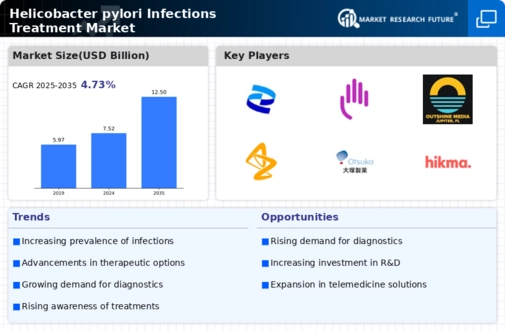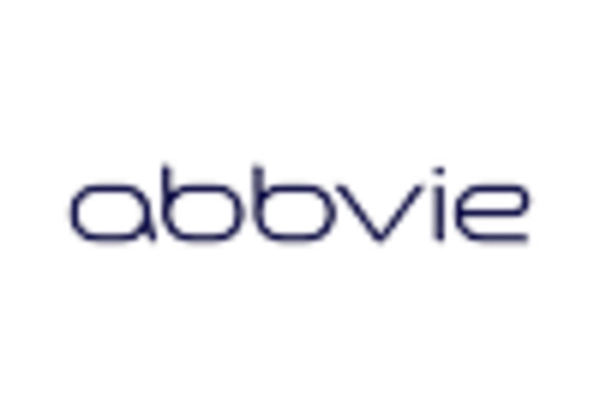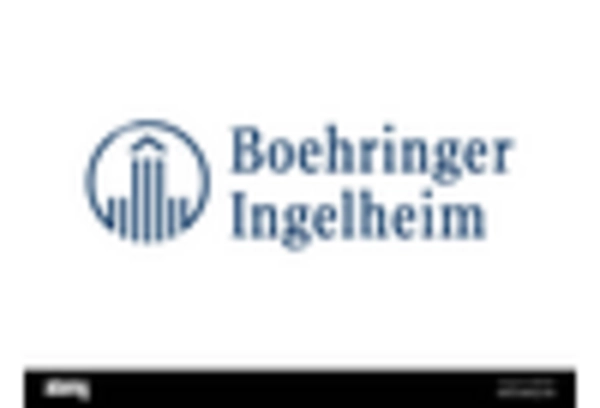Advancements in Treatment Modalities
Innovations in treatment modalities significantly influence the Helicobacter pylori Infections Treatment Market. The development of new antibiotics and alternative therapies, such as probiotics and herbal treatments, has broadened the therapeutic landscape. Recent data suggests that the introduction of novel agents may enhance eradication rates and reduce treatment failures. Additionally, the shift towards personalized medicine, where treatments are tailored to individual patient profiles, is gaining traction. This trend not only improves patient outcomes but also drives market growth as healthcare providers adopt more effective treatment strategies. The ongoing research and development efforts in this area are expected to yield promising results, further propelling the market forward.
Regulatory Support for Treatment Approvals
Regulatory bodies play a pivotal role in shaping the Helicobacter pylori Infections Treatment Market through their support for the approval of new therapies. The expedited review processes for innovative treatments and the establishment of guidelines for effective management of infections encourage pharmaceutical companies to invest in research and development. This regulatory environment fosters competition and innovation, leading to a diverse range of treatment options for healthcare providers. As new therapies receive approval, they are likely to enter the market, enhancing the overall treatment landscape. This dynamic is expected to drive market growth as healthcare professionals gain access to more effective and safer treatment alternatives.
Growing Burden of Gastrointestinal Disorders
The escalating burden of gastrointestinal disorders linked to Helicobacter pylori infections is a significant driver for the Helicobacter pylori Infections Treatment Market. Conditions such as gastritis, peptic ulcers, and gastric cancer are increasingly prevalent, necessitating effective treatment solutions. The economic impact of these disorders on healthcare systems is substantial, prompting governments and health organizations to prioritize the management of Helicobacter pylori infections. As a result, there is a growing emphasis on developing and implementing effective treatment protocols. This focus on addressing the burden of gastrointestinal diseases is likely to stimulate demand for innovative therapies, thereby contributing to the expansion of the market.
Increased Awareness and Screening Initiatives
Heightened awareness regarding Helicobacter pylori infections and their associated health risks is a crucial driver for the Helicobacter pylori Infections Treatment Market. Public health campaigns and educational initiatives have led to improved screening rates, enabling earlier detection and treatment of infections. As healthcare providers emphasize the importance of screening, particularly in high-risk populations, the demand for effective treatment options is likely to rise. Moreover, the integration of screening programs into routine healthcare practices may facilitate timely interventions, thereby reducing the burden of related diseases. This proactive approach is expected to contribute positively to market growth, as more individuals seek treatment upon diagnosis.
Rising Prevalence of Helicobacter pylori Infections
The increasing incidence of Helicobacter pylori infections is a primary driver for the Helicobacter pylori Infections Treatment Market. Studies indicate that nearly half of the world's population is infected with this bacterium, leading to various gastrointestinal disorders. The rising awareness of the health implications associated with untreated infections, such as peptic ulcers and gastric cancer, has prompted healthcare providers to seek effective treatment options. This growing prevalence is likely to stimulate demand for innovative therapies and diagnostic tools, thereby expanding the market. Furthermore, the increasing number of patients seeking medical attention for related symptoms contributes to the market's growth, as healthcare systems strive to implement effective treatment protocols.

















Leave a Comment